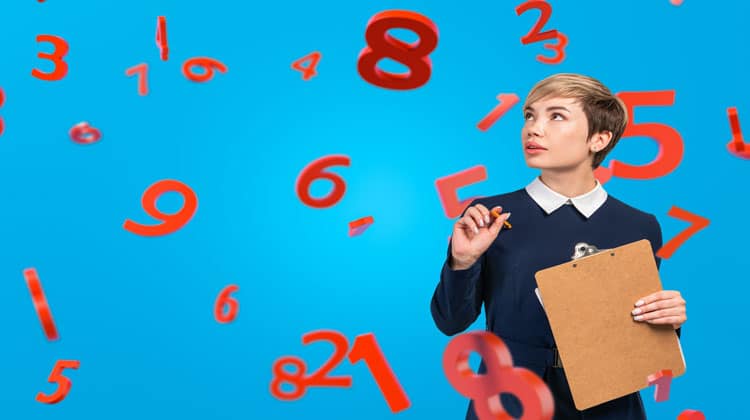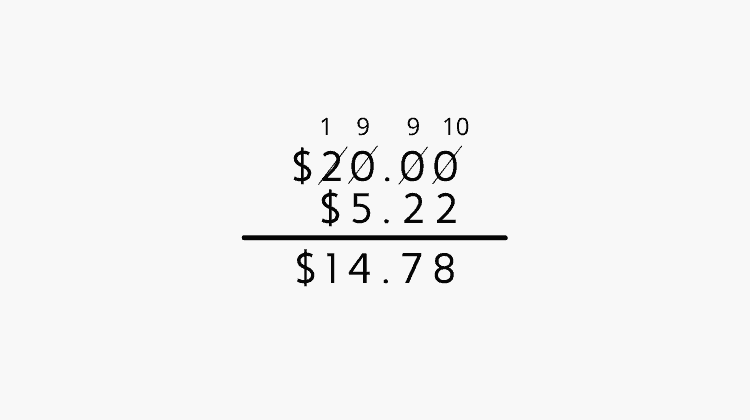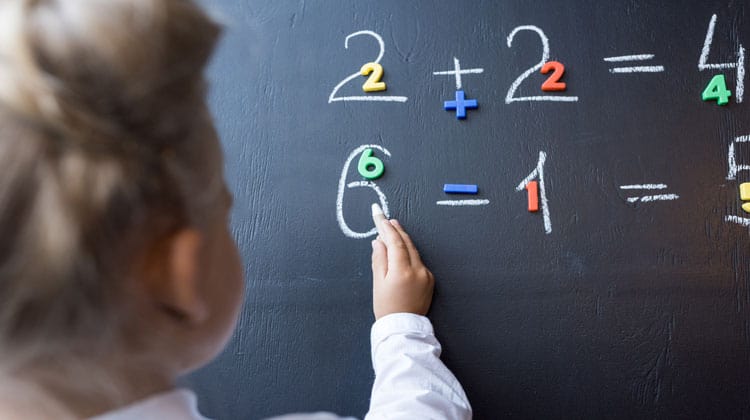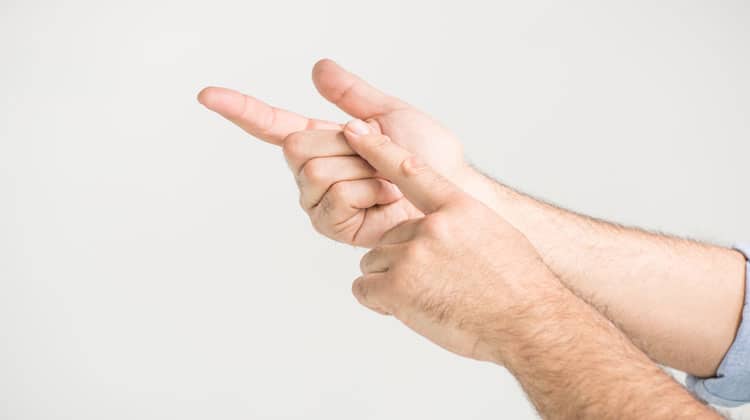THIS POST MAY CONTAIN AFFILIATE LINKS. PLEASE SEE MY DISCLOSURES. FOR MORE INFORMATION.
Counting change isn’t something that a lot of people know how to do quickly, especially in an age where we’re spending more of our money digitally.
However, it is an everyday life skill that people should know how to do.
For example, if you’re someone who works a register, knowing how to count change mentally and give the right change back will be crucial to doing your job well.
Or even if you want to start paying with cash more often, knowing how to make change is important.
If you struggle with cents, here’s how to count change in your head with greater ease.
Table of Contents
How To Count Change In Your Head FAST
Why It’s Hard To Do Math In Your Head

If you ever tried to make exact change in your head, you probably failed miserably.
This isn’t because the difficulty levels of correct change is hard, or you don’t have the math abilities to do it, it is just the way you were taught math in school.
After all, isn’t hard.
Think back for a minute to when you learned how to subtract.
If you are like most people, you learned using the borrowing method of subtraction.
For example, let’s say you are trying to subtract $5.22 from $20.
The math has you place the bigger numbers on top, $20 in this case, and the $5.22 on the bottom.
Then you work your way right to left.
In doing so, if the bottom number is larger than the top number, you need to borrow from the previous digit.
Here is what I mean by this.

If you had a pen and paper and were trying to solve for this problem, it would be rather easy.
But keeping track of all these numbers in your head gets confusing quickly.
The good news is there are a variety of simple things you can do to make counting the total amount of money in your head second nature.
#1. Brush Up On Your Math Skills
Unless you work in a career where you’re making calculations, math is not something you do on a regular basis.
For starters, it helps to familiarize yourself with the basics of addition and subtraction.
You can easily do this using online printables that students typically use.
Another option is to find apps that allow you to practice math on your phone.
By remembering how to do these basic math functions again will help to make doing math going forward like second nature.
#2. Practice Daily
If you want to get better at math, you need to make sure that you’re actively trying to sharpen these skills over time.
Making it a point to work with numbers on a regular basis helps.
By creating a habit, you better retain the knowledge you are teaching yourself.
One great way to do this is to practice at home by yourself.
For example, you can come up with your own payment scenarios and work to actively speed up your calculations.
Over time, it will become muscle memory and you can do it on the spot.
One simpler way to go about this is to look for an online money game or money skills apps that do this for you.
- Read now: Play these money saving challenges today
If you look for cashier games or math apps, you’ll find a wide range of options with varying difficulties to help you build your math skills.
While this may seem silly, working on your math is a great way to improve your brain health and make it easier for you to count change in your head.
When you want to learn how to count change in your head, you have to start somewhere.
Why not start with games and apps?
#3. Break Down The Numbers

Math is one of those subjects where people can use multiple paths to get to the correct answer.
When it comes to counting change, this is no different.
Over time, you’ll likely encounter the same numbers over and over again, making it so that you don’t actually have to do calculations.
However, here is a tip to make counting change a bit easier.
Let’s use the example above and imagine that you have a total of $5.22 and someone pays with $20.
Instead of trying to tackle it all at once, you should break it down.
Think of the grand total as two separate amounts.
You have 5 whole dollars and 22 cents.
Subtract the $5 from the $20 and you have $15.
Then, subtract the $0.22 from the $15 and you have a grand total of $14.78.
This makes it so that you’re not doing mental gymnastics to try to figure out how much to give back.
Instead, you’re breaking down the whole number and cents into individual equations to get to the total faster.
If you’re someone who’s overwhelmed by having to take on large numbers and get change, this can be a helpful tip.
- Read now: Discover the best places to find spare change
- Read now: Here is where you can turn coins into cash
#4. Break Down The Numbers And Round It Out
For some, the first step of the tip above was easy, counting the dollar bills.
But the cents part is what tripped you up.
Here is a quick way I do the mental math.
Using the same example again, I take $20 and subtract the $5 to get to $15.
The 22 cents is confusing, so I round this number down to 20 cents and subtract it from 100 to get 80 cents.
Then I take the 2 cents I rounded down from and subtract them from the 80 cents to get 78 cents.
Now I have $14.78 as change.
#5. Count Up
Another easy trick is to simply count up to find the change instead of doing subtraction.
Using the same example again, take $5.22 and count up to $6.
Go up 3 cents to get to 25 cents, then add 75 cents to this to get a total of 78 cents.
You are now at $6 and counting up to $20 gets you $14, so the total change is $14.78.
- Read now: Learn how compound interest works
#6. Work Left To Right

Instead of the traditional way of going right to left, consider going left to right.
Here you are going to look at the total not at $5.22 but as a set of numbers like 5 dollars, 20 cents, and 2 cents.
Now, take the first number $20 minus $5 to get $15.
Subtract 20 cents from $15 to get $14.80.
Finally, take 2 cents from $14.80 to get $14.78.
Here is the same formula for another problem.
Let’s say you have to make change for $10 with a total of $4.36.
Break out the number to 4 dollars, 30 cents, and 6 cents.
Take $10 and subtract $4 dollars to get $6.
Subtract 30 cents from $6 to get $5.70.
Then take 6 cents from $5.60 to get $5.64.
#7. Use Patterns To Remember Specific Change Amounts
Certain equations like the one above are quite simple.
However, giving change back isn’t always so simple.
The tips above will help you calculate mentally, but you should always be looking for patterns in cash transactions as well.
As you give change back, certain numbers will pop up time and time again.
This is especially true if you work in a setting where you’re accustomed to the prices of certain products and the amount that customers generally hand you.
Do your best to take a mental note of the money amount when you see specific numbers so that you can give that exact amount of change back to customers when you see those same numbers pop up again.
This won’t make you better at counting change, but it will help you to recognize patterns so that you don’t find yourself struggling to figure out how to count change in your head.
You’ll also have the calculator at the register, so this will give you a visual to recognize certain change patterns you’ll encounter over time.
- Read now: How much is $10 an hour annually
Final Thoughts
There are the best ways to learn how to count change in your head quickly.
Remember that you are doing basic math and you simply need to practice so you can form a habit.
There are different ways to get to the right change amount.
You need to find the one that works best for you.
Once you do this, making change mentally will happen with little effort on your part.
Finally, as you learn, pay attention to patterns.
Over time, you will develop your own shortcuts to make counting change even easier and faster for yourself.
- Read now: Learn what to do if you can’t afford Christmas gifts
- Read now: Here are the best things to sell around your house for cash
- Read now: Discover the tricks to live in your car
I have over 15 years experience in the financial services industry and 20 years investing in the stock market. I have both my undergrad and graduate degrees in Finance, and am FINRA Series 65 licensed and have a Certificate in Financial Planning.
Visit my About Me page to learn more about me and why I am your trusted personal finance expert.

